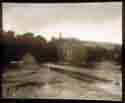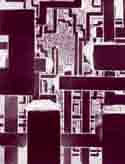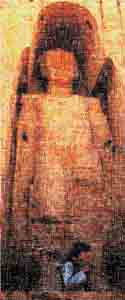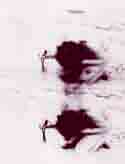Polish Photography of the 1990s. Changes, Tendencies, Artists
Krzysztof Jurecki
I am perfectly aware of the fact that my reflections and
conclusions pertaining to this problem will be incomplete for several
reasons, like my personal preferences and the difficulties connected with
the definite evaluation of the analysed phenomena.1 Only from the
perspective of the future might we know if the opinions presented here were
correct. Nevertheless, I shall try to look at the problem from the
historical point of view, from the perspective of philosophical and cultural
changes, sometimes moving beyond photography in my analyses.
I am less interested in the influence of history and recent political events which are not as important for Polish photography as they used to be in the 70s and 80s. But we are living at the threshold of a new age, marked to a large extent by the American tragedy of September 11th, 2001, which will strongly influence the functioning of culture all over the world.
Modernism versus postmodernism?
One of the most fundamental oppositions and battles of the times was fought on the borderline between modernism and the victoriously marching postmodernism, which is partly modernism’s consequence. In photography, which typically easily changes its creative costumes, this battle was rarely as dramatic as one could have thought. We observed the defense of modernist and neo-avant-garde positions (Zbigniew Warpechowski, Zbigniew Dłubak), but most of all we have to do with a peaceful transformation of modernist stylistics into artistic postmodernism which wants to be critical and provoking as the classic avant-garde and the neo-avant-garde used to be. This happens, however, in a drastically different way, as postmodernism is commercially successful in the galleries and claims that everything is allowed since there are no timeless arguments or objective social and moral laws. The crisis, and in consequence the twilight of the Polish neo-avant-garde of the 90s did not mark the twilight of modernism – which in the works of the Jelenia Góra school (Wojciech Zawadzki, Ewa Andrzejewska, Piotr Komorowski) fully blossomed in the 90s, when all their exhibitions presenting contact photography reached high artistic levels. Many talented photographers, who had often started their careers in the 80s (Marek Liksztet, Rafał Swosiński, Marek Szyryk, Eugeniusz Józefowski, Andrzej P. Bator, or the organizer of “Contacts V”, Jakub Byrczek) took part in the consecutive editions of the “Contacts” exhibitions. This type of photography is on the one hand inclined towards the alchemical nature of photography and on the other it modernises it, binding its magic by means of certain acts and tricks (Marek Gardulski, Andrzej J. Lech). That is why we can speak of the double nature of Polish photogenic photography as being the consequence of “elementary photography” which reached the apex of its development in the mid-80s. A separate place in this sphere of photography is occupied by Janusz Leśniak who in his refined works aims at a synthesis of the problem of light, spectre and shadow.
Another important centre of photography of the 90s, which might be called neo-pictorial, turned out to be Suwałki.2 The importance of this photographic centre grew due to the growing artistic authority of Stanisław J. Woś, a sensitive artist, creating unique works marked by symbolic thought and graphic character, and due to thematic exhibitions of anthropological nature (Drzewo [“Tree”], Kamień [“Stone”], Niebo [“Sky”]). Ideologically speaking, there were a few important photographers connected with Suwałki, like Tomasz Michałowski, active in the first part of the 90s, Radosław Krupiński, Grzegorz Jarmocewicz, Tadeusz Krzywicki and Ewa Przytuła. Photography from Suwałki may only seemingly be associated with postmodernism because in this case the term is misleading and inadequate with regard to the changes taking place in those circles. Only several artists, connected with the photographic club and the PAcamera gallery, make conscious references to latest American photography which is the epitome of photographic postmodernism. The Suwałki photographers, whose activity died down somewhat at the end of the 90s, want to relate to the traditional and basic values, associated both with the tradition of photography and ancient art in general.
Wiesław Barszczak rarely presented his “non-photographic” works in the 90s, consistently probing the problem of the onthology of the image which does not have to be mimetic or based on the category of realism.
The neo-avant-garde was slowly disappearing in the 90s which may be confirmed by the fact that certain followers of this tendency repeated, sometimes successfully, their media analysis repertoire. Zbigniew Dłubak has been engaged since 1981 in a dualistic series, having to do with painting and photography, called “Assymetries”, based on stable and tested models of his own. Antoni Mikołajczyk developed certain ideas from the pre-war period, related to the constructivism of László Moholy-Nagy and Henryk Stażewski. New values were rarely attained (Edward Łazikowski, Zygmunt Rytka – “Neurons” and “Elements” exhibitions in 1998, “Lying” in 2000, and Józef Robakowski, “Thermograms”, 2000). The neo-avant-garde also mingled with postmodernism (the Museum of Łódź Kaliska group), treated as a ludic game with the elements of happening.
In the article called “Photography and the Avant-garde. The Twilight of the Neo-avant-garde Formation” (“EXIT”, 1996, vol. 2), I wrote that the most cognitive works related to the rules of late modernism and reaching towards the avant-garde dialectics were created by Edward Łazikowski in his “Fragtors” series. He based his works on his own epistemological system, expressing the problem of the organization of the elementary forms of matter and referring to the theory of fractal geometry. In his case black-and-white and colour photography is but the means of fixing drawings and manual manipulations in wood dust.
The work of Leszek Golec changed in the 90s in a curious way. He combined his neo-avant-garde interests (photo-performance at the beginning of the 90s) with the ideas of buddhist philosophy. The main theme of his colour photographs became animals (cats), photographed in various places and spaces, energetic, according to the artists, since the aim of the artistic duo of Leszek Golec and Tatiana Czekalska, which came into being around 1997, is not only to help our “lesser brothers” but also to reveal sources of energy.
Polish artists, photographers included, usually are not aware that there is an abyss dividing modernism from postmodernism and their respective worldviews. This problem is rarely analysed in photographic thought, perhaps with the exception of texts by Stefan Wojnecki. The theories of postmodernism introduce fundamental changes into the traditional interpretation of artworks as well as into the meaning of the artistic subject which loses its importance.
In the 90s more and more artists became interested in postmodernism under the banner of the so-called “critical art” which employed photography. One of its important centres was the circle of the Warsaw Academy of Fine Arts (for example Katarzyna Kozyra and her “Olympia”, “Blood Ties” by Artur Żmijewski or the works of Katarzyna Górna), mainly due to its provocative character and the ability to cause sociological discussions, not because of any photographic values, usually disregarded by those artists. I was more convinced by the photographs of Jerzy Truszkowski, critical towards Polish reality, who, oddly enough, was not presented at the exhibitions of “critical art”.
Another important photographic centre turned out to be the Academy of Fine Arts in Gdańsk and the artists connected with the Island Gallery, whose leader, Grzegorz Klaman, was interested in the problems of the body enslaved within the system of power. However, I am more enthusiastic about Jarosław Bartołowicz’s photographic tableaux which employ various props. Konrad Kuzyszyn, an artist from Łódź, was also linked to the artistic circles of Gdańsk. As far as the Gdańsk Academy of Fine Arts is concerned, one might mention a few promising young artists from Witold Węgrzyn’s workshop, like Joanna Zastróżna or Patrycja Orzechowska, whose works border on graphics and photography with elements of commercial design.
Within the limits of declared or undeclared postomodern poetics the works of Sławomir Belina in the 90s also seemed promising. The artist had been collaborating earlier with the multimedia group Łódź Fabryczna (active until 1996) and referred in his photographic objects to surrealistic “found objects”.
Sometimes it is difficult to classify certain individual realizations. This is the case with the light projections of Krzysztof Wodiczko, which, according to the author, are rooted in the tradition of Polish constructivism (including the technique of the photo-montage), but in their socially interventionist aspect come close to the works of American postmodernists. Wodiczko belongs to the most famous Polish artists of the past decade, although his use of photography is quite selective. It is equally difficult to classify photographic installations by Krzysztof Cichosz who since the end of the 80s has been probing the problem of painting and photographic quotations in an attempt to rebuild values destroyed in the process of the destruction of modernism.
Modernist rationalism lies at the foundations of Marek Poźniak’s works (the “33” exhibition of 1993) and the art of Leszek Wesołowski, the author of the “Drawings” series, who from a position of a cool analyst/rationalist discusses the problems of graphics and creates different atmospheres in his works, ranging from magic to religious mystery.
Other creative attitudes, sticking closer to the rules of pre-war photogenic photography and classic American modernism (Edward Weston, Anselm Adams), are adopted by those representatives of photographic art who search for mystical and mysterious states, as well as new symbolic aspects. One might mention here certain artists of the Jelenia Góra school (Ewa Andrzejewska) or works related to this type of art by Bogdan Konopka or Andrzej J. Lech who successfully uses a pinhole camera in order to create works causing mystical astonishment.
New status of digital photography
Digital recordings which for the time being are used mostly in commercial photography allow to present unrealistic foreshortenings of perspective and various (collage-like) combinations of images, usually related to the tradition of surrealism. Among artists who more or less successfully experimented in this new field, which quickly became fundamental in Poland, one might mention Grzegorz Przyborek, Leszek Szurkowski (a theoretician of digital art), Krzysztof Gierałtowski and Barbara Konopka. Already at the end of the 80s Andreas Müller-Pohle believed that this type of photography would mark the possibilities of the further development of photographic art. Everything undergoes the process of digitalization nowadays, i.e. all forms of human activity.
Considering the poor condition of artistic reportage, whose few significant representatives in search for new values are artists like Tomasz Kizny (the “Passengers” exhibition), Anna Beata Bohdziewicz or Witold Krassowski , we must remember that a new kind of rivalry between artistic and commercial photography has been established, which is important in sociological and aesthetic aspects. But excluding Andrzej Świetlik, Tomasz Sikora, Leszek Szurkowski, Paweł Żak, Maciej Mańkowski and Zdzisław Orłowski there are still very few true professionals active in this photographic field.
Domination of staged photography
It seems that photography of the 90s in general, in various branches of art and culture, was going in the direction of various types of staging, while its inspirations lied in different branches of plastic arts, like graphics, drawing and painting, not to mention film and theatre. Ideological influences of superficially interpreted surrealism could also be seen, as well as the banality of pop-art and its stylistic mutations and continuations.
Staged photography still allows for the type of photographic attitude adopted by Grzegorz Przyborek. It is based on photographic perfectionism (and the use of his own sculptural objects), combined with the use, i.e. specific rationalization, of subconsciousness and dreams. The works of this artist belong to the most important works of the decade. Symbolic and formally surrealistic art of Tomasz Komorowski from the end of the 90s also seems promising, as in his colour works the artist shows quite rare control of form.
Wojciech Prażmowski, one of the most significant artists of the 90s and sussessful on the interantional scale, follows the direction of the “photo-object”, marked by the magic of old photography. In his case the tradition of anonymous and family photography comes to mind, which has been also developed since the 60s by Jerzy Lewczyński, the creator of “the archeology of photography”. They both believe in the cognitive and humanistic powers of art. One might also mention Aleksandra Mańczak’s collages of late 90s in which she employed family photographs in a minimalistic and conceptual way.
Similar ideas as in Prażmowski’s case, although marked by deeper criticism towards the avant-garde tradition, may be noticed in the works of Waldemar Jama, who reveals the problem of destruction and the disappearance of the “aura” of a work of art. Since the end of the 80s Tomasz Woźniakowski has been engaged in manipulations of various images, both coloured and monumental as well as miniature and partly out-of-focus.
In the 90s in Polish, as in world photography, an important place was occupied by staged photography which attacked old cultural legacy, rarely pointing to new values in the sphere of quotation (Stefan Wojnecki) or self-quotation (“Silesian Suite” by Zofia Rydet).
The most recent postmodern inspirations come from Italian (Oliviero Toscani), but mainly American photography (Jeff Koons, Andres Serrano, Robert Mapplethorpe and Joel-Peter Witkin). In Polish photography, not counting Łódź Kaliska, it is difficult to point to convincing realizations in the sphere of pastiche and quotation. Wspólnota Leeeżeć conducts its own dialogue with artistic tradition by means of both video art and photography. In the 90s the group rejected dadaistic scandals, moving in the direction of totemic light installations.
Irony, an important element of the art of the 90s, seems significant for the definition of conceptualized and formally varied art of Zbigniew Tomaszczuk (quasi reportage, photo-media, performance). Similar ideas accompany minimalistic photographs and ironic, joking “photographic objects” created by Łukasz Skąpski.
The expressionist style of Piotr Wołyński, already visible in 1991 at the “Changing of the Guards” exhibition, kept developing consistently in the 90s. This artist, overlapping or exposing photographs in different ways (“Mimoforms II”, 2000), managed to create a specific, sublime atmosphere recalling universal values.
New status of feminism3
Zofia Kulik moves in the direction of a total work, referring to political history, its personal contexts and certain religious iconographic themes, treated instrumentally. Her work may, of course, be interpreted as feminist, but it is rooted in extremely personal motivations, including those of materialistic origins, drawn from the context of the artist’s upbringing in a totalitarian state. In ways previously unknown she renewed the meaning of documents and archives, including those documenting man’s criminal acts. The artist applies the term “map” to describe her works among which one might get lost and wander if one does not know the goal of one’s quest. Kulik’s art, developing since late 80s, should be counted among the most important artistic phenomena of the 90s.4
Unquestionably successful are those women artists who may be associated with feminism only partially: Basia Sokołowska tries to revive symbolic values of old art and searches for new colourist and perspective qualities, while Irena Nawrot, who created coloured, quasi-religious photographic tableaux of personal motifs at the beginning of the 90s, turned in the second half of the decade to greater simplicity, connected with the poster-like quality of the sign and symbol.
The most recent trend in Polish feminist art may be called naive (Alicja Żebrowska, the “Onone, World After World” series, Dorota Nieznalska, Marta Deskur – the “Family” exhibition – and Zuzanna Janin). The same term may be applied to the critical reflection accompanying this feminist tendency (Izabela Kolwaczyk). For various reasons it is in opposition to the art of less expansive artists like Irena Nawrot, Danuta Kuciak or Magdalena Samborska. They present authentic, existential states devoid of the basically laughable aggression towards the imaginary masculinist world which is the fundamental assumption of the type of feminism I call naive. No wonder that women artists in quest for deep spiritual and even religious states of being (Natalia LL) retreated from ideological feminist tendencies.
The popularity of installation
Photography in the 90s often appears in the context of installation. Natalia LL was active in this field, taking up various egocentric motifs related to universal and timeless problems, like good and evil, but also to the eroticism permeating the world. Her art of this period, in comparison with her works of the 70s, became more spiritual and magical. That is why the interpretation of her art solely from the feminist point of view always impoverishes her universal message however strongly it may be connected with the neo-avant-garde consciousness.
In recent years we yet again observed a movement away from traditional rules and attempts directed at postmodernist transformations of various photographic techniques. As far as installation goes, significant multimedia works, recalling the atmosphere of old cinema, were created by Andrzej Syska (individual exhibition at the Centre for Contemporary Art in 1997 in Warsaw). He presented works resembling passages enriched by various multimedia solutions without rejecting art of modernist origins.
Two faces (types of circulation) of Polish photography
Our most important photographic galleries (the FF Gallery, the Little Gallery, the “pf” Gallery or the Empty Gallery) present their own ever-changing artistic circles, usually continuing their achievements of the 70s and 80s. However, in the 90s a new type of circulation came into being, representing the new face of photography connected with postmodern transformations. Artists presented most often at the Zachęta National Gallery of Art and at the Centre for Contemporary Art in Warsaw are not interested in photography as an independent visual discipline, but, as the neo-avant-garde before them, make use of it in their artistic projects which are often scandalous in character. The most notorious exhibition of this type was “The Nazis” by Piotr Uklański (shown at the Zachęta National Gallery of Art in 2000). A few of the works presented there were destroyed and the exhibition was prematurely closed. Those two types of circulation exist in isolation side by side, merging only occasionally (Zofia Kulik, Natalia LL).
One of the more important exhibitions of the last decade, called Bliżej fotografii [“Closer to Photography”] (1996) further popularized the photogenic trend which is characterized by sticking to basic photographic invariables, although the influences of other tendencies is also visible (for example conceptualism, surrealism and abstraction). As a result at the important “1st Biennale of Polish Photography” (1998) this tendency, contrary to all expectations, turned out to be most expressive and convincing, thus forming an important trend in the photography of the 90s.
The most important periodic photographic show remains the Konfrontacje Fotograficzne [“Photographic Confrontations”] in Gorzów Wielkopolski. Annual competition exhibitions hosted in the 90s several prominent artistic figures like Tomasz Michałowski, Leszek Wesołowski, Stanisław Woś, Radosław Krupiński, Lech Polcyn, Paweł Żak and Sławomir Kubala – one of the biggest talents which appeared in photography and graphics at the end of the 90s. The show in Gorzów included all significant tendencies of the 90s, and catalogues as well as historical and theoretical material - of different quality - were also published there. A largely regionalized show of a lesser rank was organized in Żary and called Krajowy Salon Fotografii Artystycznej [“The National Salon of Artistic Photography”].
In 1997 and 1998 two large exhibitions were organized in Cracow by the Turlej Foundation, called “Photography ‘97” and “Photography ‘98”. They were confrontations of various tendencies and stylistics which resulted in eclecticism and very uneven level of the works presented. Comprehensive catalogues successfully recapitulated various transformations which took place on the artistic scene, not only in the90s.
New ideas, new attitudes
By the end of the 90s many photographers, exhausted by staged photography, returned to documentary photography, often employing pinhole photography and old cameras (Wojciech Prażmowski, Konrad Kuzyszyn, Marek Poźniak or Artur Chrzanowski). The photographic document, although often unnoticed, has always been an important element in the history of photography.
At the same time photographers from the circle of the Academy of Fine Arts in Poznań (Jakub Bąkowski, Magdalena Poprawska) began to reveal conceptual interests (enriched by theoretical reflections) whose results were shown, for example, at the “2nd Biennale of Photography” (the Arsenal Gallery, 2000, Poznań). High artistic potential characterizes some students and graduates of the Higher School of Photography “afa” from Wrocław, which was confirmed by two exhibitions: “Cielesność ciala. Natalia LL i jej studenci [“The Corporality of the Body. Natalia LL and Her Students”] and Dotyk poznania [“The Touch of Knowledge”].
Time will force some of them to move towards commercial photography or graphic design, since the cultural possibilities of postmodernity open new perspectives in those fields.
Notes:
1 This text develops ideas presented previously in another article. See K. Jurecki, “Polish Photography of the 90s. A summary”, in: “FOTOGRAFIA ‘98”, the Turlej Foundation, Cracow 1998 (catalogue of the exhibition). See also: A. Sobota, “Fotografia polska lat dziewięćdziesiątych” [“Polish Photography of the 90s”], Galeria “pf” Gallery, Poznań 1998.
2 K. Jurecki, “Where Is Photography Heading for? The Pacamera Photography Inclusive!”, in: “Rytuały i symbole. Artyści z kręgu Pacamera Club w Suwałkach” [Rituals and Symbols. Artists of the PAcamera Circle in Suwałki], the Arsenal Gallery, Białystok 1999 (catalogue of the exhibition).
3 Two most important exhibitions connected with Polish feminism, called “Kobieta o kobiecie” [“Woman on Woman”], took place in 1996 and 2001 at the BWA [Bureau of Artistic Exhibitions] in Bielsko-Biała. A pioneer collection of texts was also published there, entitled “Sztuka kobiet [“The Art of Women”], edited by J. Ciesielska and A. Smalcerz, BWA, Bielsko-Biała 2000.
4 Certain ornamental motifs of Zofia Kulik’s style, especially the plastic sign, were also noticeable at the beginning of the 90s in the extremely promising work of Jerzy Sadowski, a graduate of the National Higher School of Fine Arts in Poznań.





